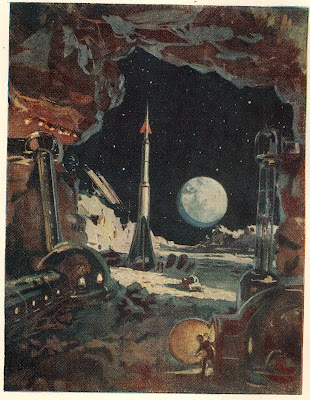
An updating of a 1958 book, this will be my last Russian for a while. It has been fun but as the 50s melt into the 60s the illustrations become more factual and less awesome.
I have been intrigued by how the flavor of these books changed very little over the decade. The books started out predicting space flight as an ultimate goal of the Russian people and ends with showing that it had been predicted all along and changes to concentrating on the true exploits of the Russian people.
The same subjects of the painting appear again and again but the visionary art is amazing. The romantic sense of these pictures is hard to deny. This impressionism was lacking from many of the western paintings of this same technology.




 Thanks for the kind comments. I am afraid this series has used up a couple of months of my blogger storage space. I couldn't resist however showing some of the unseen art. When I discovered these books I was thrilled. Since I have no Russian language skill finding them has been hit or miss for me but I treasure each one I have found.
Thanks for the kind comments. I am afraid this series has used up a couple of months of my blogger storage space. I couldn't resist however showing some of the unseen art. When I discovered these books I was thrilled. Since I have no Russian language skill finding them has been hit or miss for me but I treasure each one I have found.





 But the illustrations were the same and I knew I had found a winner. This is the gold medal of space books. Tons and tons of full color illustrations showing children how man will go to space and what it will look like. Of course it starts off explaining about rockets and showing their launch.
But the illustrations were the same and I knew I had found a winner. This is the gold medal of space books. Tons and tons of full color illustrations showing children how man will go to space and what it will look like. Of course it starts off explaining about rockets and showing their launch.



 They laid out the idea for a moon trip in an elegant series of drawings that make the whole mission seems very easy. In 1959 it seemed to every child that we were just a few steps from standing on the Moon.
They laid out the idea for a moon trip in an elegant series of drawings that make the whole mission seems very easy. In 1959 it seemed to every child that we were just a few steps from standing on the Moon.









 For the "fans" of spaceflight this was a vindication of their dreaming and prodding of others to make rockets real. It took rockets as a weapon to get people to build improved ones, but it was the ability to put something in orbit that was encouraged by these visionaries. There are very few military reasons to bother putting something in orbit but a whole bunch of scientific and creative ones.
For the "fans" of spaceflight this was a vindication of their dreaming and prodding of others to make rockets real. It took rockets as a weapon to get people to build improved ones, but it was the ability to put something in orbit that was encouraged by these visionaries. There are very few military reasons to bother putting something in orbit but a whole bunch of scientific and creative ones. This is a 82 page pamphlet about Tsiolkovsky. Part of a classroom series for younger readers.
This is a 82 page pamphlet about Tsiolkovsky. Part of a classroom series for younger readers.











 From our vacation on Mars :)
From our vacation on Mars :)

 Illustration from these books look very similar to those from 10 years later. Astronauts in launch couches and weightless explorers in earth orbit filled these books.
Illustration from these books look very similar to those from 10 years later. Astronauts in launch couches and weightless explorers in earth orbit filled these books. A landing on the Moon was a foregone conclusion. I particular like this book which predicted robot explorers getting there first.
A landing on the Moon was a foregone conclusion. I particular like this book which predicted robot explorers getting there first. But almost all of these books show this image. Men standing on the Moon next to their spaceship. The rockets were all traditonal V-2 shaped but the illustrations often gave the sense that this was not the first visit but rather one of many.
But almost all of these books show this image. Men standing on the Moon next to their spaceship. The rockets were all traditonal V-2 shaped but the illustrations often gave the sense that this was not the first visit but rather one of many.






 In addition to telling children how the world would change, there is a lot of inspirational power in showing children doing these activities. Showing children on the Moon sticks with them a lot more than just telling about the possibilities.
In addition to telling children how the world would change, there is a lot of inspirational power in showing children doing these activities. Showing children on the Moon sticks with them a lot more than just telling about the possibilities.


